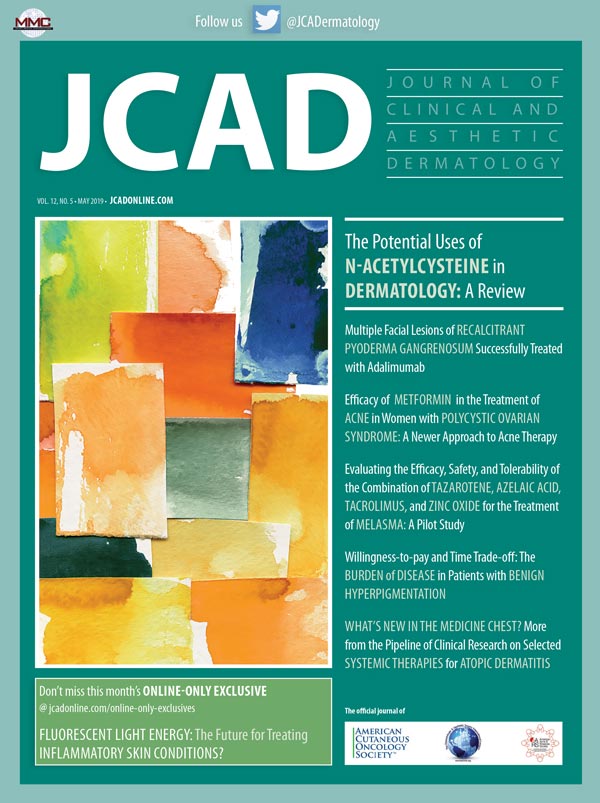VOL. 12, NO. 5 • MAY 2019
 Dear Colleagues:
Dear Colleagues:
Welcome to the May 2019 issue of The Journal of Clinical and Aesthetic Dermatology. We start this issue with a review article titled, “The Potential Uses of N-acetylcysteine (NAC) in Dermatology: A Review.” Here, Janeczek et al review clinical trials that assessed the efficacy of NAC in various cutaneous disorders. The authors report that efficacy of NAC was shown in excoriation disorder, onychophagia disorder, trichotillomania, acne vulgaris, Type I lamellar ichthyosis, bullous morphea, systemic sclerosis, toxic epidermal necrolysis, atopic dermatitis, xeroderma pigmentosum, and pseudoporphyria, as well as in wound healing and photoprotection. The authors conclude that NAC has the potential to serve as a safe, tolerable, and effective therapeutic option for a variety of dermatologic conditions.
Next, Kleinfelder et al present a case report titled, “Multiple Facial Lesions of Recalcitrant Pyoderma Gangrenosum (PG) Successfully Treated with Adalimumab.” The authors describe the case of a 52-year-old man with no known history of underlying systemic disease who developed multiple treatment-resistant facial lesions of PG. The authors report ultimate success clearing the disease using adalimumab.
Following this, in a study titled, “Efficacy of Metformin in the Treatment of Acne in Women with Polycystic Ovarian Syndrome (PCOS): A Newer Approach to Acne Therapy,” Sharma et al evaluated the efficacy of metformin therapy in women with acne and PCOS in terms of acne severity. In this hospital-based, interventional, longitudinal study that included 40 female patients with acne and PCOS, study participants were administered 500mg of metformin three times a day for eight weeks. Patients were assessed for acne severity at multiple time points. The authors report that metformin treatment significantly reduced acne severity study participants (p<0.001), and, despite study limitations, including small sample size and short follow-up period, the authors conclude that metformin might potentially serve as a treatment to improve acne severity in women with PCOS.
Next, Kirsch et al present their study titled, “Evaluating the Efficacy, Safety, and Tolerability of the Combination of Tazarotene, Azelaic Acid, Tacrolimus, and Zinc Oxide for the Treatment of Melasma: A Pilot Study.” Here, investigators assessed a novel composition (2013-MCN-333) comprising tazarotene 0.075%, azelaic acid 20%, tacrolimus 0.1%, and (microfine) zinc oxide 10% for the treatment of moderate-to-severe melasma in 16 patients. Study participants were treated daily with sunscreen and 2013-MCN-333 for 20 weeks. Primary outcome measure was change in Melasma Area and Severity Index (MASI) score. The authors report that 25 percent of patients met the primary endpoint of a MASI score of less than eight points at Week 20, concluding that the study drug could potentially serve as an effective, safe, and tolerable treatment for moderate-to-severe melasma.
Following this, in a study titled, “Willingness-to-pay (WTP) and Time Trade-off (TTO): The Burden of Disease in Patients with Benign Hyperpigmentation,” Maymone et al conducted a cross-sectional pilot study that included 85 adults with benign hyperpigmentation. Using a survey questionnaire, the authors assessed WTP and TTO as methods to quantify the disease burden. The authors report that the survey results indicated disease burden was high, overall, for benign hyperpigmentation conditions, concluding that patient-centered methods of assessing impact on quality of life should be incorporated into clinic protocol.
Next, in the latest installment of What’s New in the Medicine Chest by Del Rosso titled, “More from the Pipeline of Clinical Research on Selected Systemic Therapies for Atopic Dermatitis,” the author reviews several systemic therapies under development for atopic dermatitis, including IgE-directed therapy, anti-IL-31, anti-IL-5, anti-IL-22, PDE-4 inhibition, and thymic stromal lymphopoietin (TSLP)-directed therapy.
Finally, don’t miss this month’s online exclusive, “Fluorescent Light Energy (FLE): The Future for Treating Inflammatory Skin Conditions?” by Edge et al. Here, researchers investigated the cellular mechanism of action of FLE on key skin and immune cells. Based on their results, the authors report that FLE is capable of enhancing collagen production, modulating cutaneous inflammation, and encouraging angiogenesis. A clinical presentation of inflammation in a representative patient with acne vulgaris is included for illustrative purposes.
We hope you enjoy this issue of JCAD. As always, we welcome your feedback and submissions.
With regards,
James Q. Del Rosso, DO, FAOCD—Editor-in-Chief, Clinical Dermatology
Wm. Philip Werschler, MD, FAAD, FAACS—Editor-in-Chief, Aesthetic Dermatology
Seemal R. Desai, MD, FAAD— Associate Editor

